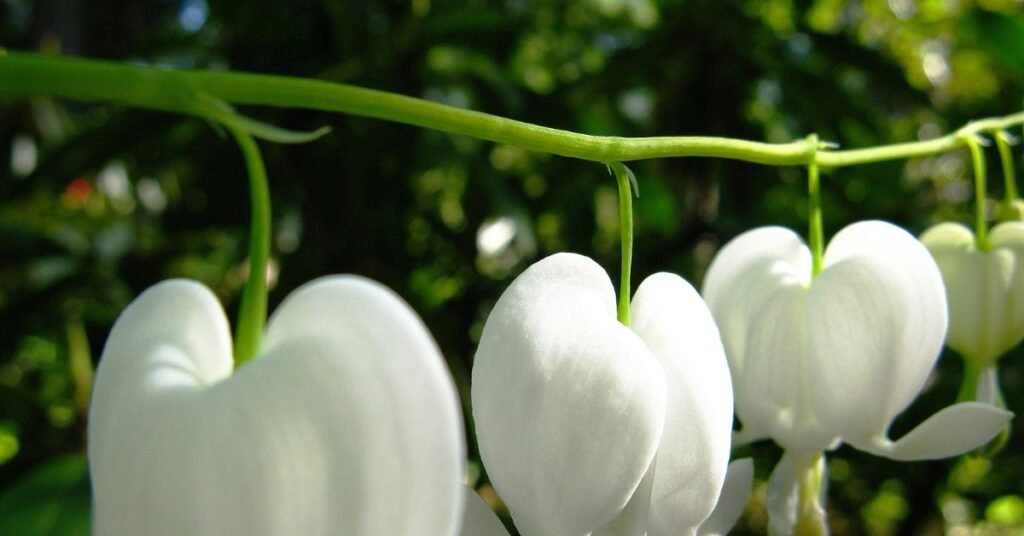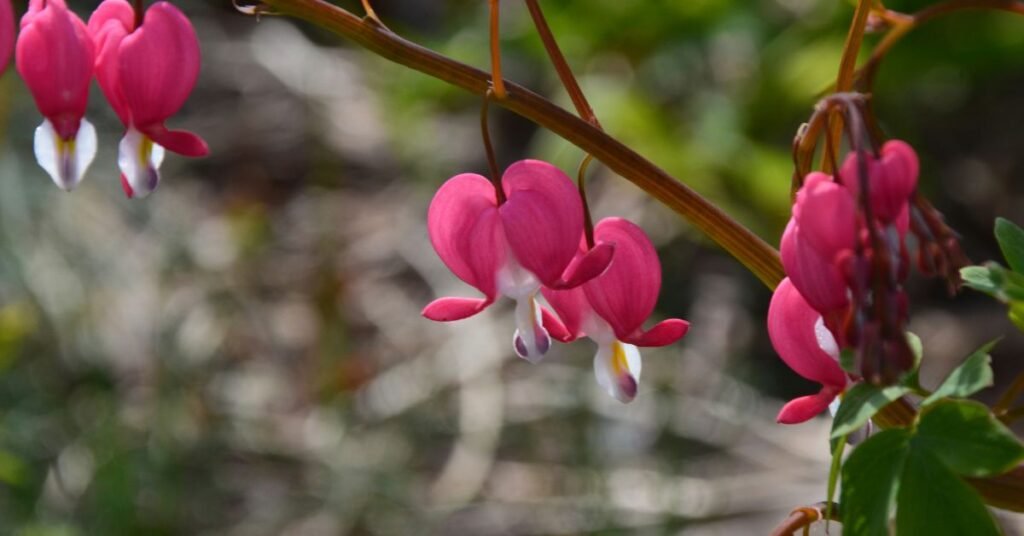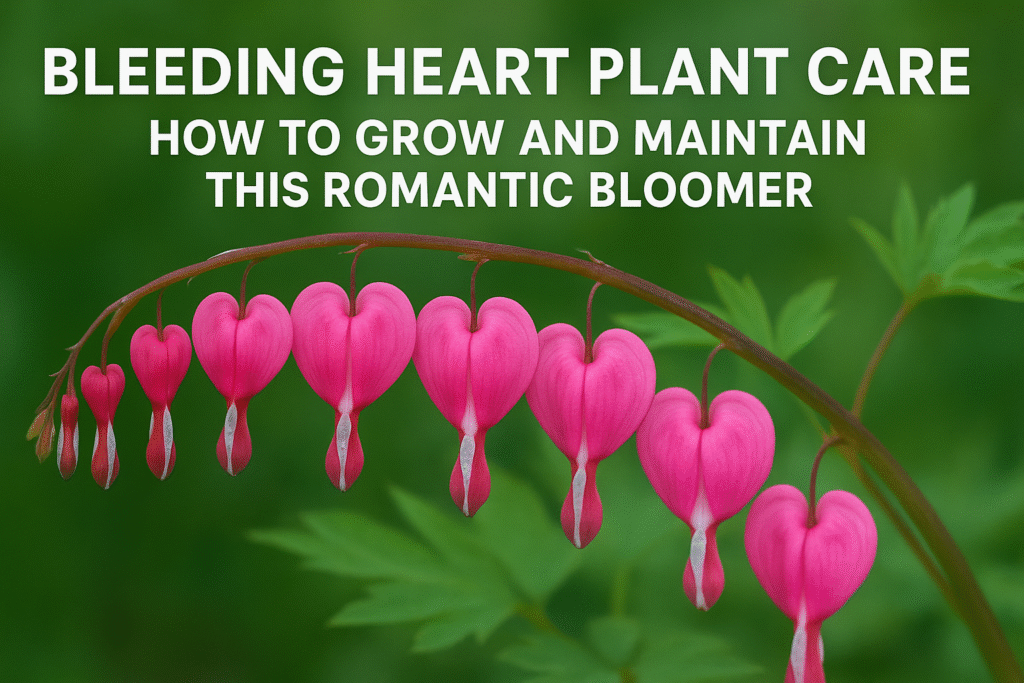The Bleeding Heart Plant, scientifically known as Dicentra spectabilis, is one of the most romantic and graceful flowering plants you can grow. Its heart-shaped pink or white blossoms dangle delicately from arching stems, creating a captivating look in shady gardens. Native to Asia, this perennial has become a beloved favorite in gardens across the world for its charm, easy care, and timeless beauty.
Overview of the Bleeding Heart Plant
The Bleeding Heart Plant is part of the Papaveraceae family and thrives in cool, shaded environments. It’s a perennial that dies back in the heat of summer but re-emerges beautifully each spring.
Common Names: Bleeding Heart, Lady-in-a-Bath
Scientific Name: Dicentra spectabilis
Type: Herbaceous perennial
Height: 1–3 feet
Bloom Time: Spring to early summer
USDA Hardiness Zones: 3–9

Appearance and Bloom Characteristics
This plant is famous for its unique heart-shaped flowers with a small teardrop beneath — symbolizing love and compassion.
Flowers hang gracefully from arched stems and bloom in pink, white, or red shades. Its fern-like foliage adds an elegant texture to shaded landscapes.
Ideal Growing Conditions
Light Requirements
Bleeding Heart Plants thrive in partial to full shade.
Too much direct sunlight can scorch their tender leaves, especially in hotter regions. Morning sun and afternoon shade are ideal.
Temperature and Humidity
These plants prefer cool temperatures (15°C–22°C / 59°F–72°F).
They love moist air but dislike hot, dry climates. Mulching helps retain soil moisture during warmer months.
Soil Preferences
Use well-draining, rich soil with plenty of organic matter.
A mixture of garden soil, peat moss, and compost ensures proper drainage and nutrients. The soil should remain slightly moist but never soggy.
Watering Needs
The Bleeding Heart Plant enjoys consistently moist soil, especially during active growth and blooming periods.
- Water when the top inch of soil feels dry.
- Avoid letting the soil dry completely.
- Reduce watering once the plant starts to die back in summer.
Tip: Mulch around the base to help retain moisture and regulate soil temperature.
Fertilizing for Healthy Growth
Fertilize your Bleeding Heart Plant once every 4–6 weeks during spring using a balanced 10-10-10 fertilizer.
Avoid excessive nitrogen—it promotes leafy growth but fewer blooms.
You can also enrich the soil with organic compost before the growing season begins.
Pruning and Maintenance
Pruning is important for keeping the Bleeding Heart looking neat and encouraging new growth:
- Cut back spent flower stems after blooming.
- Once the foliage turns yellow and dies back in summer, trim it to the ground.
- New growth will appear again next spring.
Note: The plant naturally goes dormant after flowering, so yellowing leaves are normal — not a sign of disease.
Propagation Methods
Division
The easiest way to propagate a Bleeding Heart is by root division:
- Dig up the plant in early spring or fall.
- Gently separate the root clumps with your hands.
- Replant divisions about 18 inches apart in moist, shady soil.
Seeds
You can also grow it from seeds, but germination is slow and may take a full year for flowering.
Common Problems and Solutions
Yellow Leaves
If the leaves yellow too early, it could be due to overwatering or too much sun. Move the plant to a shaded spot and check soil moisture.
Pests and Diseases
The Bleeding Heart Plant is mostly pest-resistant but may occasionally attract aphids, snails, or slugs.
Use organic insecticidal soap or handpick pests if needed.
For fungal diseases like powdery mildew, ensure good air circulation and avoid overhead watering.
Root Rot
Caused by poor drainage. Always use well-draining soil and pots with holes.
Seasonal Care Tips
| Season | Care Routine |
|---|---|
| Spring | Active growth — keep soil moist and fertilize monthly. |
| Summer | Plant may go dormant — reduce watering. |
| Autumn | Divide roots or replant. |
| Winter | Apply mulch for frost protection. |
Companion Plants
Bleeding Hearts pair beautifully with:
- Hostas
- Ferns
- Astilbes
- Brunneras
These shade-loving companions complement its pink blooms and maintain garden texture even after the Bleeding Heart fades.
Benefits of Growing Bleeding Heart
- Adds a romantic touch to shady gardens
- Low maintenance once established
- Great for borders, woodland gardens, and containers
- Attracts butterflies and pollinators
- Symbol of love and compassion

Frequently Asked Questions (FAQ)
Is the Bleeding Heart Plant toxic?
Yes — it’s mildly toxic if ingested, so keep it away from pets and children.
How long do Bleeding Heart blooms last?
They typically bloom for 4–6 weeks during spring and early summer.
Can I grow Bleeding Heart indoors?
It’s best grown outdoors due to its size and dormancy cycle, but can survive indoors temporarily with proper light and humidity.
Final Thoughts
The Bleeding Heart Plant is truly one of nature’s most poetic creations. Its heart-shaped blossoms make it a garden favorite for expressing love and tranquility. With proper care — shaded light, rich soil, and steady moisture — this plant will return year after year, bringing joy with every bloom.

